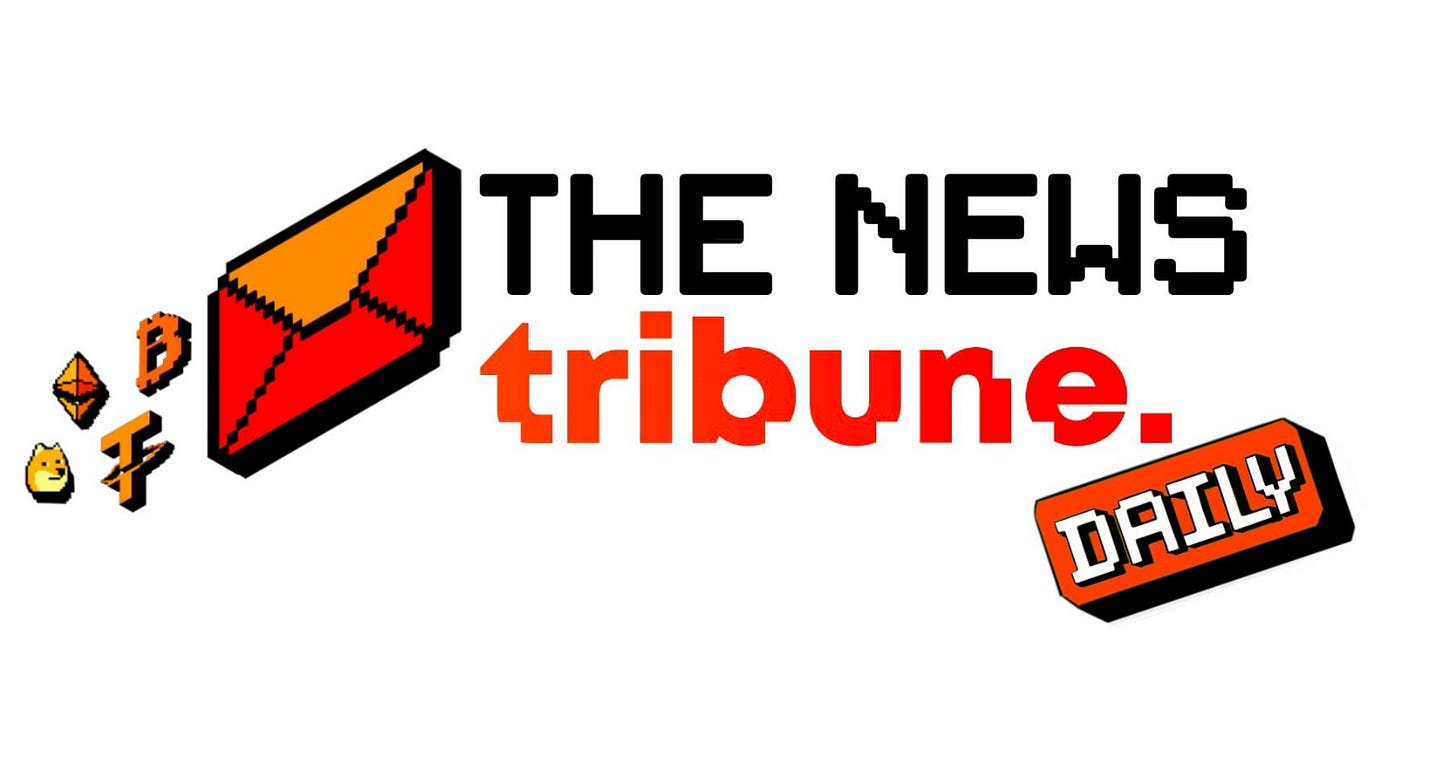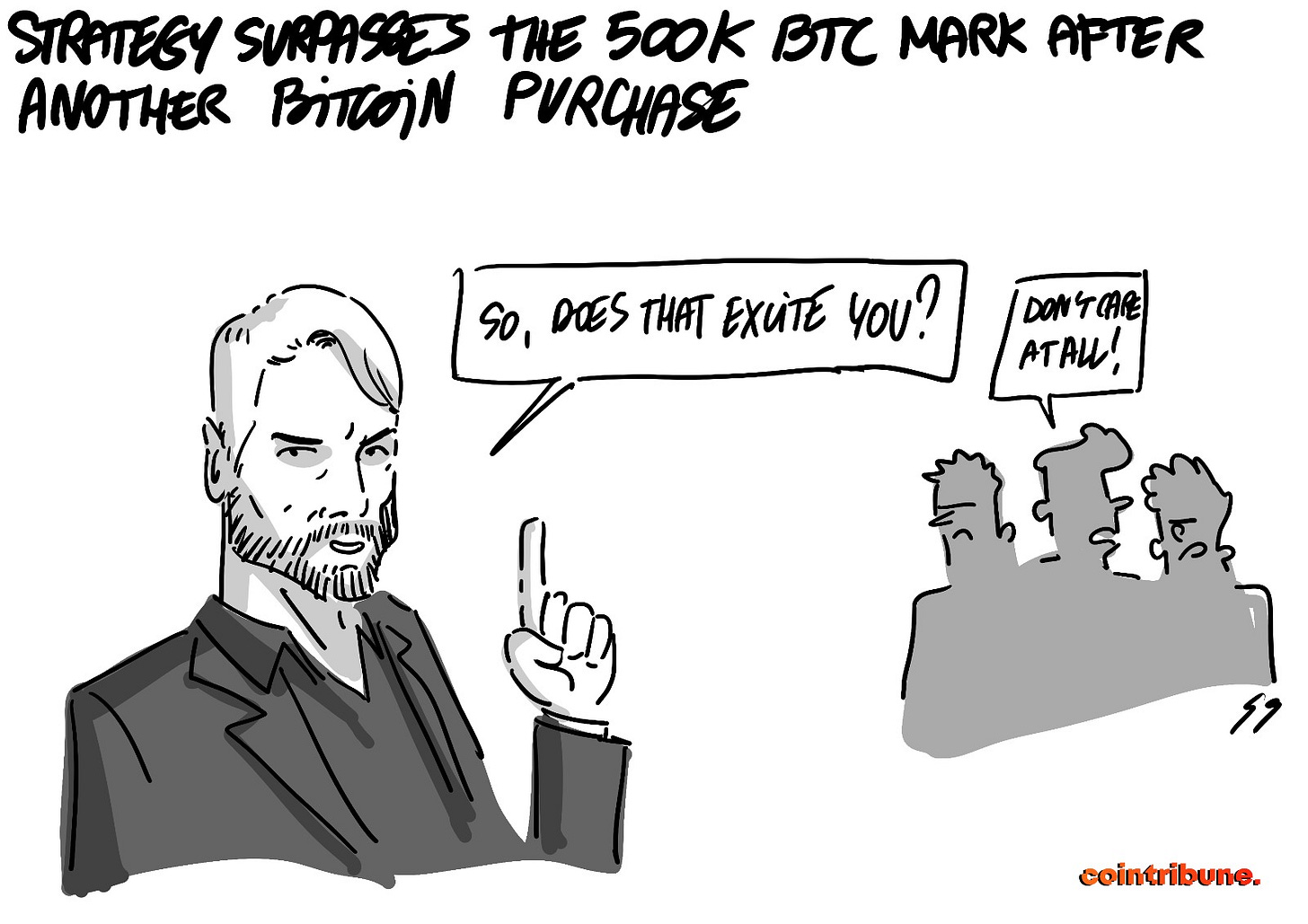💰 Michael Saylor is still stacking more Bitcoin!
Welcome to the Daily tribune for Tuesday, March 25, 2025 ☕️
Happy New Year to Cointribu! 🚀
Today is Tuesday, March 25, 2025, and like every day from Tuesday to Saturday, we summarize the news of the last 24 hours that you shouldn’t have missed!
But first…
✍️ Cartoon of the day:
A quick look at the market…
🌡️ Temperature:
🌤️Partially cloudy ⛅
24h crypto recap! ⏱
Strategy crosses the threshold of 500,000 BTC after a new bitcoin purchase
Strategy (former MicroStrategy) surpasses 500,000 BTC after purchasing 6,911 BTC for 584 million dollars. The company now owns 2.4% of the global BTC supply and claims its status as a leader in Bitcoin accumulation.
This partnership between OpenAI and Visa conceals a colossal issue
OpenAI and Visa are teaming up to launch a universal crypto wallet via Worldcoin, integrating stablecoin payments. This ambitious project could revolutionize transactions by merging fiat currency and cryptos.
Trump declares his memecoin is the best
Donald Trump has publicly endorsed his memecoin $TRUMP, leading to a 7.7% surge in price. The direct promotion of this asset sparks ethical debates, particularly due to its majority ownership by companies affiliated with Trump.
Metaplanet invests 12.6 million dollars in Bitcoin after Eric Trump’s arrival
Metaplanet, with Eric Trump on the advisory board, buys an additional 150 BTC, bringing its reserve to 3,350 BTC. The company aims to reach 21,000 BTC by the end of 2026 to consolidate its position in Asia.
The crypto of the day: Berachain (BERA)
Berachain is a high-performance layer 1 blockchain, compatible with the EVM (Ethereum Virtual Machine), which introduces an innovative consensus mechanism called Proof of Liquidity (PoL). This mechanism aligns network security with liquidity provision, thus creating a cooperative economy that rewards active capital and fosters ecosystem growth.
The native token of Berachain, BERA, primarily serves to pay transaction fees on the network, acting as the "gas token" that facilitates operations within the ecosystem. Furthermore, BERA is used to run validation nodes, thereby contributing to the security and stability of the network. The Berachain ecosystem relies on a tri-token system also comprising BGT (Berachain Governance Token), a non-transferable governance token allowing holders to participate in decisions regarding the network's evolution, and HONEY, an integrated stablecoin providing stable value for transactions within the ecosystem.
Recent performances:
Current price: $7.63 (approximately €7.05)
24-hour change: +11.55%
Market capitalization: $818.33 million
Rank on CoinMarketCap: #77
Why have crypto exchanges still not listed Pi Network?
Despite its 47 million users, Pi Network remains absent from major exchange platforms like Binance or Bybit. This situation is particularly intriguing given the project's strong popularity among its community. However, several key elements explain this blockage and reveal the deep-seated reasons for the reluctance of centralized exchanges.
1. A tokenomics deemed opaque
One of the main obstacles lies in the lack of transparency regarding the project's tokenomics. Experts believe that the Pi Network team has not clearly defined the mechanisms for locking or destroying tokens, which are essential elements to ensure the project's credibility.
Recently, the removal of 10 million tokens has reduced the circulating supply to 6.77 billion, without any official explanation. This decision has raised questions about the team's real intentions, with some suggesting market manipulation in view of a future listing. For exchange platforms, this opacity represents a major risk, especially as regulators increasingly demand transparency in the management of digital assets.
2. A controversial strategic choice
Pi Network also appears to be refusing to comply with the commercial demands of exchanges, particularly regarding listing fees. According to some sources, the Pi team has deliberately refused to pay the fees required by Binance and Bybit, considering this course of action as an infringement on its independence.
This position may appeal to some supporters of decentralization, but it considerably complicates access to greater liquidity and hinders listing on major platforms. Without a presence on a major exchange, institutional speculation remains limited, and the project risks remaining on the fringes of the traditional crypto market.
3. The distrust of institutional investors
Finally, the lack of clear communication and the excessively centralized governance of the project fuel doubts about the reliability of Pi Network. Strategic decisions are often made without community consultation or prior communication, which goes against the practices expected in the modern crypto ecosystem.
Moreover, in the absence of listing on recognized centralized platforms, the liquidity of the token remains very low, which reduces its appeal to institutional investors. For Pi Network, successfully convincing the major exchanges therefore requires greater transparency and a more participatory governance.
A popularity rating, but a lack of credibility
Despite its massive community, Pi Network struggles to convince centralized exchanges of its solidity and transparency. As long as these aspects are not clarified, the cryptocurrency risks remaining a marginal project, supported by a base of loyal users but not keen on attracting major institutional investors. To overcome this hurdle, Pi will need to demonstrate greater transparency and align with the governance standards expected by listing platforms.









